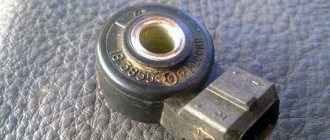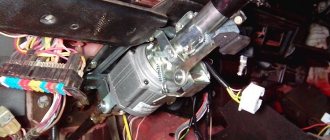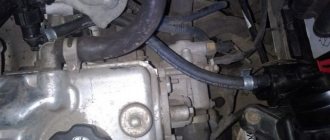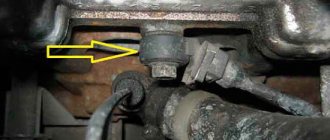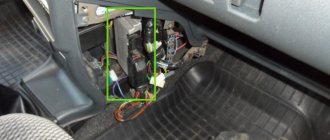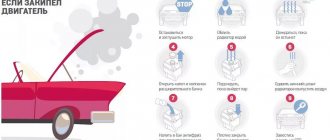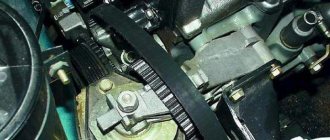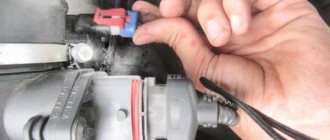The smooth operation of the internal combustion engine under various loads is ensured by special devices that promptly notify the mini-computer of changing operating conditions. The knock sensor is one of the most important devices in such a system.
Detonation is a very dangerous process.
Modern domestic cars are also equipped with a product of this type. The sixteen-valve Lada Priora is equipped with a piezoceramic device of this type, which will be discussed in this article.
Purpose
The knock sensor is a small device that is installed on injection engines. In case of uncontrolled combustion of the fuel mixture, regardless of the cause, the device automatically changes the ignition timing of the fuel mixture.
The importance of this device for engine safety is difficult to overestimate. Even if the car is fully tuned and its main parts are made without defects, then no one is safe from refueling with low-quality fuel.
As a result of using low-quality fuel, the working parts of the piston group may fail when the vehicle's mileage is less than 10,000 km. This device allows you to protect the internal combustion engine from the harmful effects of explosive gasoline combustion.
Engine detonation: what is this process and features of its manifestation
The phenomenon of detonation is familiar to many who have driven Zhiguli and Moskvich cars and filled them with AI-76 gasoline instead of the prescribed A-80. As a result, the detonation process did not take long to occur and manifested itself mainly after the ignition was turned off. At the same time, the engine continued to function, and caused surprise and even laughter on the face of an inexperienced driver. However, there is little good in this phenomenon, because with this process the CPG wears out very quickly, which leads to a decrease in engine life, and as a result, engine malfunctions appear.
On modern fuel-injected cars, detonation also occurs, and not only due to poor quality or inappropriate fuel being poured into the tank. The reasons for the occurrence of such a process are various factors, and before we get acquainted with them, we will find out what the engine detonation effect is and why it is so dangerous.
Detonation is a phenomenon in which spontaneous ignition of the mixture in the combustion chamber occurs without the supply of a spark from the spark plugs. The result of this process is unstable operation of the engine, and the consequences are not long in coming, and if this effect occurs frequently, problems with the engine may soon begin. In this process, not only the CPG comes under attack, but also the gas distribution mechanism.
To prevent the prolonged occurrence of this process, a knock sensor is used in the design of modern injection cars. It is a kind of noise eliminator that transmits information about abnormal engine operation to the electronic control unit. Next, the ECU makes an appropriate decision on the possibility of promptly eliminating the problem.
Where is
To carry out the necessary diagnostic or repair work, you need to know where the knock meter is located.
Lada Priora 16 valves. Finding this device will not be difficult. For correct operation, the vibration diagnostic device is located on the block, in close proximity to cylinder 1.
In this place, vibration is most clearly felt in the presence of detonation, which makes it possible to timely register deviations in engine operation.
The danger of detonation effect on a car and the reasons for its occurrence
Detonation loads are dangerous for any internal combustion engine, and that is why all manufacturers of modern cars equip units with special sensors. Such devices do not exclude the possibility of a process occurring, but warn of its occurrence, which allows the controller to quickly resort to eliminating the problem.
To appreciate the danger of such a process, which is called internal combustion engine detonation, you should look at the photo below.
They depict engine parts that were removed during repair work. The piston and valve suffered such severe destruction precisely because of spontaneous ignition of the fuel in the combustion chambers. The piston and valve are not the only parts that experience accelerated wear during detonation. Because of this phenomenon, other parts, such as the crankshaft and crank mechanism, also experience strong loads.
The causes of engine detonation loads are the following factors:
- Fuel octane number mismatch. If the manufacturer recommends using A-95 gasoline, then using low-octane fuel is strictly contraindicated. Detonation, which occurs due to fuel mismatch, contributes to the formation of carbon deposits, which provokes the development of glow ignition. As a result, after turning off the ignition, the engine continues to function, which is manifested due to the ignition of the fuel assembly from the hot electrodes of the spark plug.
- Operating conditions and driving habits. Very often, engine detonation occurs among inexperienced drivers when upshifting occurs at too low a vehicle speed and with insufficient crankshaft revolutions. It is important to switch to the next gear when the engine speed on the tachometer is between 2.5-3 thousand rpm. If you switch to a higher gear without first accelerating the car, it is possible that a characteristic metallic knock will occur in the area of the engine compartment. This knock is engine detonation. Such detonation is called permissible, and when it occurs, it does not last long.
- Design features of the engine - cars that are equipped with turbocharging are especially susceptible to the development of a negative phenomenon. This effect often occurs if the car is fueled with low-octane fuel. This also includes factors such as the shape of the combustion chamber and tuning (boosting) the internal combustion engine.
- Incorrect setting of the ignition timing angle. However, this phenomenon is more common on carburetor engines, and on an injector it can occur, among other things, due to a malfunction of the knock sensor. If the ignition is too early, the fuel will ignite much earlier than the piston reaches top dead center.
- A high degree of compression in the cylinders often occurs when the engine cylinders are heavily coked. The more carbon deposits on the cylinder walls, the higher the likelihood of detonation loads developing.
- Lean fuel assembly. If a mixture with a low amount of fuel is supplied to the combustion chamber, the high temperature of the spark plug electrodes contributes to detonation. A small amount of gasoline and a large volume of air leads to the development of oxidative reactions that respond to increased temperature. This reason is typical for injection engines, and usually appears only on a warm engine (usually at crankshaft speeds of 2 to 3 thousand).
This is interesting! Very often, the cause of self-ignition of fuel assemblies in cylinders is associated with a change in the ECU firmware. This is usually done to reduce fuel consumption, but the engine suffers from such a whim of the car owner. After all, one of the reasons for the development of detonation load is a lean mixture.
If the knock sensor fails, this will not cause detonation processes. If the ECU does not receive the appropriate information from the DD, it will go into emergency mode when the ignition timing is adjusted with a deviation towards late ignition.
This, in turn, will entail many negative consequences: increased fuel consumption, decreased dynamics, power and instability of the internal combustion engine.
How to check
You can check the Lada Priora 16 valve sensor with a multimeter. To check the sensitive element, it is necessary to switch the tester to the mode for measuring electrical resistance of 20 MOhm. Then you should connect the test device to the sensor contacts. Use a small metal object to lightly tap the body of the product. If the device is faulty, the readings will not change. If the detonation device is in perfect order, then such actions will certainly lead to an increase in the output resistance of the device, which will be recorded using a measuring device.
Price
The knock sensor cannot be repaired and if it malfunctions, it only needs to be replaced with a new sensor. Fortunately, its price is not high, and there are also enough non-original, high-quality analogues on the market, which are listed below in the table. There are no differences between DD in engines with 8 and 16 valves; the sensors for both types of engines are exactly the same.
Below is a table with the article number and cost of the knock sensor for the Lada Priora
| Manufacturer | vendor code | Price (rubles) |
| LADA (original) | 21123855020 | 200-400 |
| Samara, 2112 | 3855020 | 180-250 |
| ERA | 550489 | 300-400 |
| "Road map" | 21123855020 | 250-360 |
| Decaro | 2112-3855020 | 380-500 |
| Fenox | SD10100O7 | 200-400 |
Replacing the sensor
This part must be replaced from the oil dipstick side.
The work is performed in the following sequence:
- Disconnect the wires.
- Unscrew the fastening bolt.
- Remove the sensor.
- Install a new product (tightening torque should be 20–25 Nm).
- Connect the wires.
- Check the functionality of the product.
You can fully check the serviceability of the Lada Priora knock sensor only on the track, where you can test the engine at various speeds. If after the check-in the symptoms of the malfunction remain the same, then the new device should be checked with a multimeter. If the method described above using a tester makes it possible to establish that the detonation device is not “involved” in the unstable operation of the engine, then the breakdown should be looked for elsewhere.
Required Tools
Table - Tools and materials required to replace the knock sensor
| Name | Note |
| Socket wrench or socket | “at 10”, “at 13″”, “at 19” |
| Vorotok | With ratchet |
| Torque wrench | To check the tightening of the knock sensor fastening |
| Rags and wire brush | To clean dirt |
| Penetrating lubricant | To release stuck threaded fastenings of the crankcase protection |
Work should be carried out with access from the bottom of the car. Therefore, it is recommended to proceed with independent replacement if there is an inspection hole or overpass.
